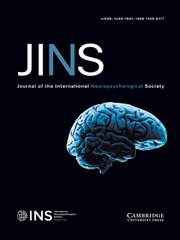Introduction
How to choose the best criteria for mild cognitive impairment? When relevant information is missing
I have read with much interest the work by Chang et al. (Reference Chang, Wang, Qin, Katz, Byrd, Lipton and Rabin2024) recently published in the Journal of the International Neuropsychological Society, in which the predictive validity for incident dementia of four Mild Cognitive Impairment (MCI) definitions are compared. The authors report no statistically significant differences with regards to the Youden’s Index or Hazard ratios, but differences were reported among the four approaches with regards to sensitivity and specificity to identify progressors. I found this work very interesting and timing, as the concept of MCI has evolved and so should the way objective cognitive impairment is identified in people with suspected cognitive impairment, since neuropsychologists know that obtaining one or more low scores is common when several measures are included in the neuropsychological battery (Brooks et al., Reference Brooks, Iverson, Holdnack and Feldman2008; Palmer, Reference Palmer1998). However, after my reading of the paper, I feel that some important information is missing in the work by Chang et al. (Reference Chang, Wang, Qin, Katz, Byrd, Lipton and Rabin2024) that deserves some discussion. The authors identified progressors to dementia through a 2–7 years period, and then calculated sensitivity and specificity metrics for each MCI definition. However, what I think researchers or clinicians will find more useful is the predictive power of each definition to identify progressors, as there is no way of knowing who will progress to dementia upon neuropsychological assessment. Whilst sensitivity indicates the percentage of individuals who progress to dementia and were classified as MCI at baseline, the Positive Predictive Value (PPV) represents the percentage of individuals classified as MCI at baseline who later progress to dementia (i.e, the risk of progression; Glaros & Kline, Reference Glaros and Kline1988). Tabulating the data reported in tables 1 and 3 in Chang et al. (Reference Chang, Wang, Qin, Katz, Byrd, Lipton and Rabin2024) for the 2-year follow-up period, Table 1 shows the PPV and the Negative Predictive Value (NPV) for each MCI definition (with minor changes likely due to differences in decimal places). These data show that taking into account several low scores provides the highest PPV without compromising the NPV, with the Number of Impaired Tests (NIT) definition (Oltra-Cucarella et al., Reference Oltra-Cucarella, Sánchez-SanSegundo, Lipnicki, Sachdev, Crawford, Pérez-Vicente, Cabello and Ferrer-Cascales2018) almost doubling (∼11%) the other three definitions’ PPV (∼6%). Chang et al. (Reference Chang, Wang, Qin, Katz, Byrd, Lipton and Rabin2024) accurately discuss the strengths and weaknesses of each MCI definition, but fail to add the important information reported here. The Petersen/Winblad criteria require only one low score, whereas the Jak/Bondi criteria include only six measures, which is uncommon in neuropsychological assessment. The NIT are more flexible as they can be calculated for a different number of measures in a battery or for different numbers of measures within a cognitive domain. I would recommend that researchers developing normative data for neuropsychological tests report the NIT for their particular battery, for clinicians using that battery to be able to compare different MCI definitions. Taking into account the normal variability in cognitive functioning might be more useful to identify individuals at the greatest risk of progressing from MCI to dementia, and the NIT criteria seem to be very useful when the diagnosis of objective cognitive impairment is the main purpose.
Table 1. Positive and negative predictive values for each mild cognitive impairment definition

Notes: NIT: number of impaired tests, Global CR: global clinical rating, MCI: mild cognitive impairment, Sen: sensitivity = a / (a + c), Spec: specificity = d / (b + d), PPV: positive predictive value = a / (a + b), NPV: negative predictive value = d / (c + d), See Glaros and Kline (Reference Glaros and Kline1988) for a detailed explanation of diagnostic statistics
Acknowledgements
I thank Prof. Rafael de Andrade Moral and Prof. Unai Díaz-Orueta for their insightful comments.
Funding statement
None.
Competing interests
None.



